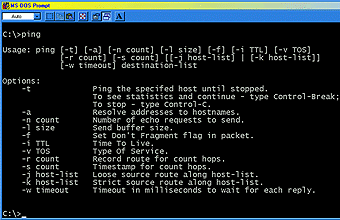Software Watch: Ping!
Windows NT 4.0 excels at offering good, solid TCP/IP utilities. Any tech
worth his or her troubleshooting guns should especially be familiar with the
TCP/IP diagnostic utilities. These utilities provide invaluable bullet-proof
data for network problems on the client side, server side, and everywhere in
between.
The best diagnostic utility is the Packet Internet Groper (PING)—the basic
tool for verifying connectivity. PING sends Internet Control Message Protocol (ICMP)
echo packets to a host and waits for echo reply packets. If PING can reach the
host, you will see a few lines similar to these:
C:\ ping 192.2.2.99
Pinging 192.2.2.99 with 32 bytes of data:
Reply from 192.2.2.99: bytes=32 time=62ms TTL=255
Reply from 192.2.2.99: bytes=32 time=62ms TTL=255
Reply from 192.2.2.99: bytes=32 time=62ms TTL=255
Reply from 192.2.2.99: bytes=32 time=62ms TTL=255
If PING can't reach the host, you will see the message Request timed out.
This usually means that the Network Interface Card (NIC) isn't plugged in
properly, the CAT 5 cable isn't correctly connected to a port, or the server is
down.
PING's capabilities are overlooked more often than not. As shown in Figure A,
there's more than meets the eye when PING is enhanced with switches.

Figure A You can use these switches with the PING command.
A few scenarios when these switches are helpful include:
Ping of Death? -t switch is the one
Monster packets? -l switch for those swarms of bytes rolled into one (up to
8,192!)
Long lasting flavor? -i TTL specs the echo packet with your definition. The
lower the TTL, the better your response time. This is especially important for
those fraggers out there looking for less or no lag on the Quake II server over
the Net.
You can see how these little utilities can be best adapted to your personal
"devices."
You can incrementally send PING to troubleshoot your network neighborhood. PING
localhost and you'll get the loopback response from 127.0.0.1 notifying you that
you basically know how to install a network card the correct way.
You can also send a PING out to the server. If WINS or DNS has been implemented,
you can type c:\ ping SERVER1 and successfully get a response. This is
helpful when you're trying to determine whether the PC you're on is
acknowledging the server.
On a larger scale, like a Wide Area Network (WAN), PING is a good way to check
that the router/gateway is configured correctly. You should rarely have problems
pinging inside the router. However, if you're having trouble getting out to the
Internet, another subnet, or a virtual LAN, it's a good bet the problem is on
the far side of the router. The gateway IP is either wrong or set incorrectly.
Until this is reconfigured correctly, you'll never hit the Web from your side of
the subnet.
Many factors can affect your PING reading. For example, the distance of the
host, the number of hops over routers necessary to get to the host and back, and
busy servers can all be detrimental. PING will provide you with very specific,
informative data. As we all know, "He who holds the information holds the
keys."

